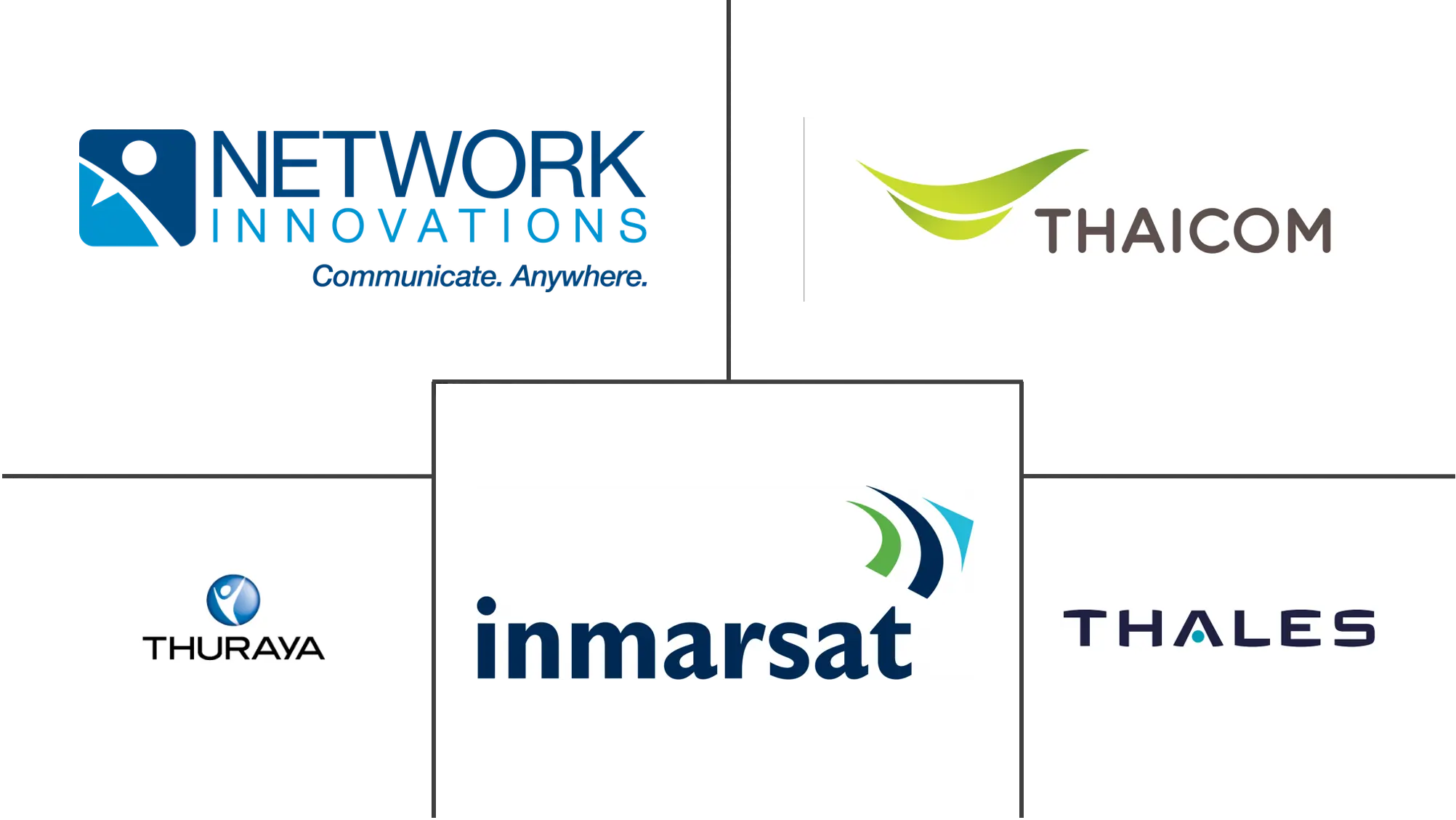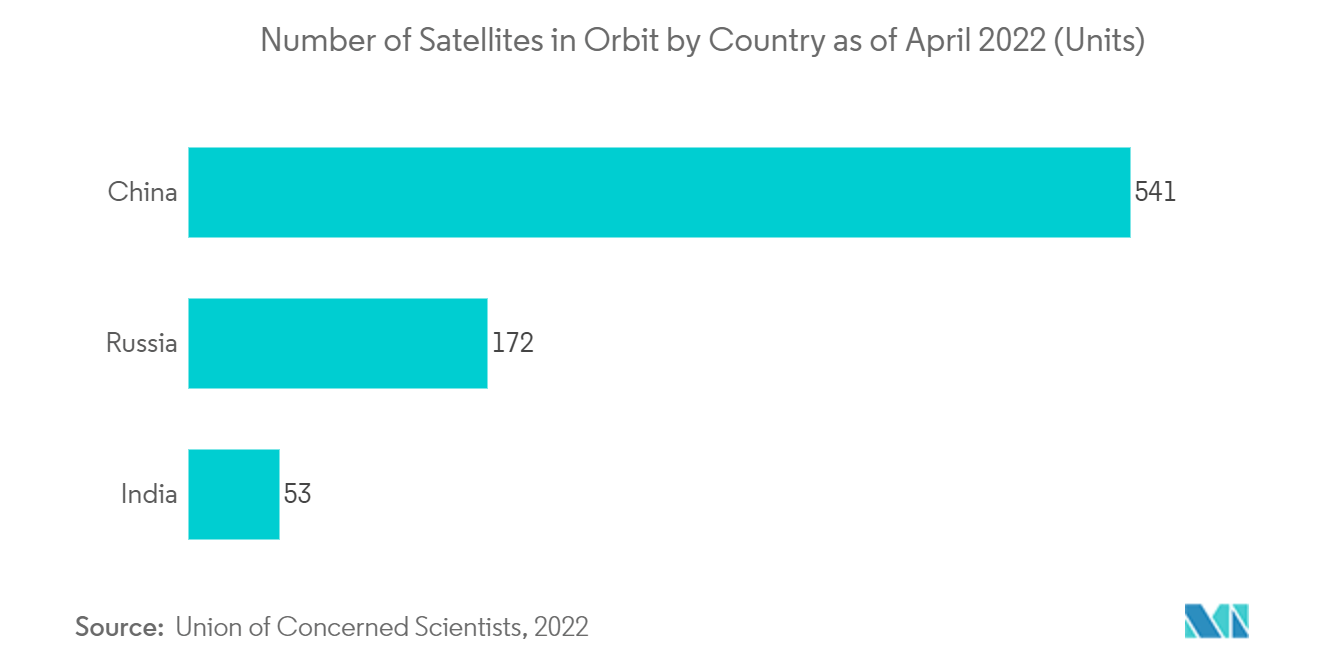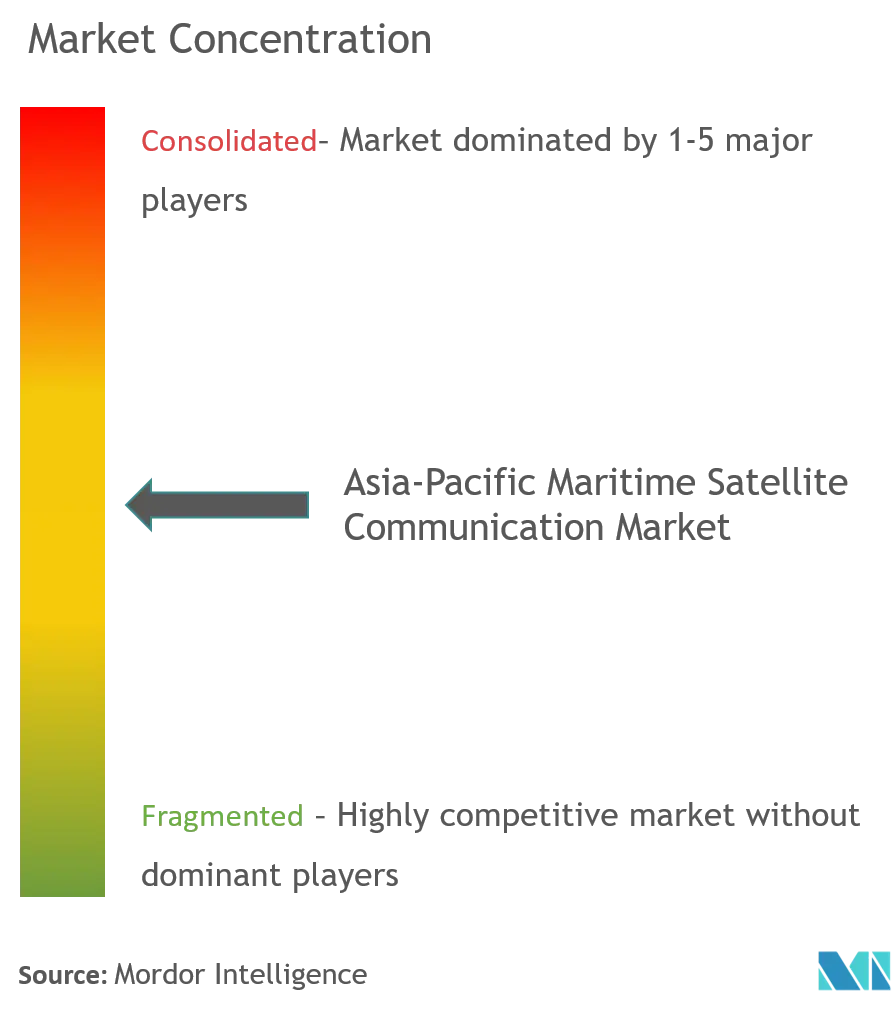Asia-Pacific Maritime Satellite Communication Market Size

| Study Period | 2021 - 2029 |
| Base Year For Estimation | 2023 |
| Forecast Data Period | 2024 - 2029 |
| Historical Data Period | 2021 - 2022 |
| CAGR | 11.32 % |
| Market Concentration | Medium |
Major Players
*Disclaimer: Major Players sorted in no particular order |
Asia-Pacific Maritime Satellite Communication Market Analysis
The Asia-Pacific maritime satellite communication market is expected to register a CAGR of approximately 11.32% during the forecast period. The major factor driving the market growth is increased sea-borne threats and ambiguous maritime security policies in the region.
- With the ship traffic in the Asia-Pacific region increasing significantly, it has become crucial to improve safety and security and safeguard the environment. Per the IBEF, two years ago, cargo traffic increased by 1.69% year-on-year to 1561.0 million tons in India. Major Indian ports handled 720.29 million tonnes of freight volume in the current year. India's exports of goods were USD 417800.0 million in the current year, an increase of 40% from the previous year.
- Commercial vessels, like container ships, need reliable satellite communications to stay connected to their main offices and support crew welfare activities. Satellite services can also offer coverage and an effective communication channel to help relief operations during emergencies.
- Maritime satellite communication will play a crucial role in autonomous ships, which seek to make ships self-driven to boost competency and productivity, thus allowing efficient task performance. It minimizes human mistakes by lowering the labor needed to operate the ship. These ship designs are now the subject of experiments, but they appear promising in the long run. These ships will be largely crewless and equipped with various new and improved technologies, including tracking systems, sophisticated sensors to avoid obstacles, positioning systems to keep them informed about alternate routes, and control systems so that teams on the shore can operate the ships in specific emergencies. These ships maintain a constant connection with the team ashore and, as a result, need sophisticated tools and systems.
- India intends to spend USD 8200.0 million on port construction projects by 2035. Adani Group stated that it aims to have all of its data centers powered by renewable energy by 2030 and that Adani Port will have zero carbon emissions by 2025. These factors will further act as secondary driving factors for the maritime satellite communication device and service growth in the forecast period.
Asia-Pacific Maritime Satellite Communication Market Trends
This section covers the major market trends shaping the APAC Maritime Satellite Communication Market according to our research experts:
Government Agencies are Expected to Have the Largest Market Share in the Region
- Increased spending on marine products and services by various governments across the region, increased security threats, increased water transport and trade numbers, and other tracking are critical drivers of market growth.
- Moreover, many government agencies face an ongoing challenge in providing essential telephony services throughout their countries. Many governments worldwide have turned to VSAT networks for a low-cost, reliable public telephony solution to meet this challenge. Very Small Aperture Terminal (VSAT) networks represent the most cost-effective solution for communities where public service telephone network (PSTN) services are unavailable, overloaded, or too expensive.
- Further, emerging countries, such as India, China, Japan, and South Korea, continuously increase their defense budgets year-over-year to strengthen their national security. The government of India is planning to handle the issue of threats by implementing a national automatic identification system for India's coastline safety and security.
- A uniform communication strategy for coastal security was adopted this year by the Indian Ministry of Home Affairs (MHA). It calls for connecting marine law enforcement organizations to a single network for improved coordination and seamless sharing of mission-critical data. With a designated spectrum for the purpose, the scheme will be able to combine all coastal security agencies into a single communication network. A "major stride" in enhancing coastal security, the specialized spectrum will make use of a common frequency.
- Also, the China Belt and Road Initiative and Pearl River Delta expansion projects undertaken by the government are further expected to boost the market's growth during the forecast period.

China Expected to Dominate the Market
- Due to the substantial trade influx, China is expected to lead the maritime satellite communication market in the Asia-Pacific region. China is an essential market for passenger vessels in the area.
- Moreover, countries like China are vital in promoting maritime security since the naval industry adds to the region's economic growth. The Chinese central government took the initiative to encourage intelligent shipping development in the country. Under this initiative, the government mentioned working in collaboration with various government agencies to complete the strategy design for intellectual shipping development by the end of 2020, further improve brilliant shipping service, safety, environment protection level, and efficiency by 2035, and establish a high-quality smart shipping system by 2050.
- This year, in November, China launched a high-power communications satellite to connect travelers on airplanes, ships, and other users in China, Southeast Asia, and remote routes connecting the Asia-Pacific area and North America. A Long March 3B rocket carrying the Chinasat 19, or Zhongxing 19, communications satellite launched from the Xichang launch site in the Sichuan province of southwest China. A hazardous hydrazine-fueled core stage and booster engines propelled the Long March 3B into space. Within the first three minutes of flight, the rocket dropped its strap-on boosters and core stage, and a second stage subsequently took over to continue the rocket's ascent into space.
- Furthermore, the companies in the country are witnessing strategic collaborations as a lucrative path toward growth. For instance, Gilat Satellite Networks and China Satellite Communications collaborated to deploy Gilat's DVB-S2X technologies throughout China to jointly provide satellite communication services covering aeronautical, terrestrial, and maritime fixed and mobility applications.

Asia-Pacific Maritime Satellite Communication Industry Overview
The competitive landscape of the maritime satellite communication market in the Asia-Pacific region is expected to move toward moderate fragmentation. The market players in the region and the governments of various countries in the region are taking several initiatives for innovation to improve the maritime security of the nations. Also, the market players are forming strategic partnerships and collaborations to boost their market presence in the Asia-Pacific region and globally. For instance,
- In March 2022, shipyards can use Fleet Xpress, a market-leading maritime broadband service from mobile satellite communications company Inmarsat. Fleet Xpress for Shipyards, which is installed during new construction, saves time-consuming and expensive installation tasks at ports by providing owners with a pre-fitted very small aperture terminal (VSAT) solution included in the vessel's initial purchase price.
- In January 2022, Network Innovations (NI) acquired STS Worldwide Inc., one of the most established global ground systems integrators in the satellite business, which provides turnkey network systems and engineering design. With services to link clients in distant regions, send vital data, provide secure networks, and more, STS Global has made sure that dependable services are available everywhere on Earth.
- In May 2022, Thaicom Public Company Limited offered its premier end-to-end satellite communications solutions for a range of clients, including the Nava Global Maritime Broadband Platform and Thaicom Express Wi-Fi, a high-speed broadband hotspot service.
Asia-Pacific Maritime Satellite Communication Market Leaders
-
Inmarsat Group Ltd.
-
Network Innovation Inc.
-
Thuraya Telecommunications Company
-
Thaicom PCL
-
Thales Group
*Disclaimer: Major Players sorted in no particular order

Asia-Pacific Maritime Satellite Communication Market News
- December 2022: In order to create a future, highly adaptable, software-defined satellite, Eutelsat Communications chose Thales Alenia Space (SDS). The Flexsat, short for "flexible satellite," will be based on Thales Alenia Space's state-of-the-art "Space Inspire" (instant space in-orbit reconfiguration) product line, which enables seamless reconfiguration and instant in-orbit adjustment to provide an exceptional level of customer service while maximizing the efficient use of satellite resources.
- August 2022: For the launch of its Superbird-9 communications satellite, SKY Perfect JSAT Holdings Inc. chose SpaceX's Starship. Superbird-9 is a highly adaptable HTS (high-throughput satellite). The payload missions can be customized and integrated to meet end-user needs. To meet the demands for mobility and broadband, it will supply broadcast and broadband missions in the Ku band, especially over Japan and Eastern Asia. In 2024, Superbird-9 will be launched into geosynchronous transfer orbit by SpaceX's Starship rocket. The world's most potent launch vehicle will be SpaceX's Starship, a reusable transportation system.
Asia-Pacific Maritime Satellite Communication Market Report - Table of Contents
1. INTRODUCTION
- 1.1 Study Assumptions and Market Definition
- 1.2 Scope of the Study
2. RESEARCH METHODOLOGY
3. EXECUTIVE SUMMARY
4. MARKET DYNAMICS
- 4.1 Market Overview
-
4.2 Industry Attractiveness - Porter's Five Forces Analysis
- 4.2.1 Bargaining Power of Suppliers
- 4.2.2 Bargaining Power of Consumers
- 4.2.3 Threat of New Entrants
- 4.2.4 Intensity of Competitive Rivalry
- 4.2.5 Threat of Substitute Products
- 4.3 Assessment of the impact of COVID-19 on the industry
-
4.4 Market Drivers
- 4.4.1 Increased Sea-borne Threats and Ambiguous Maritime Security Policies
- 4.4.2 Need for Advanced Communications along SLOC
-
4.5 Market Restraints
- 4.5.1 Reliance on High-Cost Satellite Equipment
5. MARKET SEGMENTATION
-
5.1 Type
- 5.1.1 Mobile Satellite Communication
- 5.1.2 Very Small Aperture Terminal (VSAT)
-
5.2 Offerings
- 5.2.1 Solution
- 5.2.2 Services
-
5.3 End-user Industry
- 5.3.1 Government
- 5.3.2 Merchant Shipping
- 5.3.3 Offshore
- 5.3.4 Passenger Ships
- 5.3.5 Leisure Vessels
- 5.3.6 Fishing
-
5.4 Country
- 5.4.1 China
- 5.4.2 South Korea
- 5.4.3 Singapore
- 5.4.4 India
- 5.4.5 Japan
- 5.4.6 Rest of Asia-Pacific
6. COMPETITIVE LANDSCAPE
-
6.1 Company Profiles
- 6.1.1 Inmarsat Group Ltd
- 6.1.2 Network Innovation Inc.
- 6.1.3 Thuraya Telecommunications Company
- 6.1.4 Thaicom PCL
- 6.1.5 Thales Group
- 6.1.6 Intelsat SA
- 6.1.7 Asia Satellite Telecommunications Holdings Ltd
- 6.1.8 Speedcast International Ltd (Globecomm Systems Inc.)
- 6.1.9 The SKY Perfect JSAT Group
- 6.1.10 Singapore Telecommunications Ltd
- 6.1.11 Eutelsat Asia PTE Ltd
- *List Not Exhaustive
7. INVESTMENT ANALYSIS
8. FUTURE OF THE MARKET
** Subject To AvailablityAsia-Pacific Maritime Satellite Communication Industry Segmentation
Satellite communication technologies help track ships and cargo throughout the globe. The study characterizes the satellite communication market based on technology type and offering, which includes solutions and services, and end-user vertical. The scope of the study is currently focused on key Asian-Pacific countries, such as China, Singapore, India, Japan, and South Korea, among others.
The Asia-Pacific Maritime Satellite Communication Market is Segmented By Type (Mobile Satellite Communication and Very Small Aperture Terminal), by Offerings (Solution and Service), by End-user Industry (Government, Merchant Shipping, Offshore, Passenger Ships, Leisure Vessels, and Fishing), and by Country.
The market sizes and forecasts are provided in terms of value (USD million) for all the above segments.
| Type | Mobile Satellite Communication |
| Very Small Aperture Terminal (VSAT) | |
| Offerings | Solution |
| Services | |
| End-user Industry | Government |
| Merchant Shipping | |
| Offshore | |
| Passenger Ships | |
| Leisure Vessels | |
| Fishing | |
| Country | China |
| South Korea | |
| Singapore | |
| India | |
| Japan | |
| Rest of Asia-Pacific |
Asia-Pacific Maritime Satellite Communication Market Research FAQs
What is the current Asia-Pacific Maritime Satellite Communication Market size?
The Asia-Pacific Maritime Satellite Communication Market is projected to register a CAGR of 11.32% during the forecast period (2024-2029)
Who are the key players in Asia-Pacific Maritime Satellite Communication Market?
Inmarsat Group Ltd., Network Innovation Inc., Thuraya Telecommunications Company, Thaicom PCL and Thales Group are the major companies operating in the Asia-Pacific Maritime Satellite Communication Market.
What years does this Asia-Pacific Maritime Satellite Communication Market cover?
The report covers the Asia-Pacific Maritime Satellite Communication Market historical market size for years: 2021, 2022 and 2023. The report also forecasts the Asia-Pacific Maritime Satellite Communication Market size for years: 2024, 2025, 2026, 2027, 2028 and 2029.
Asia Pacific Maritime Information Industry Report
Statistics for the 2024 Asia Pacific Maritime Information market share, size and revenue growth rate, created by Mordor Intelligence™ Industry Reports. Asia Pacific Maritime Information analysis includes a market forecast outlook 2029 and historical overview. Get a sample of this industry analysis as a free report PDF download.



